
The Ultimate Guide to Finding the Best Small Cooler for Your Needs
Why a Small Cooler Makes Every Trip Better
A small cooler is your perfect companion for keeping food and drinks cold during day trips, work lunches, and outdoor trips. These portable cooling solutions typically hold 6-30 cans, offer 12-48 hours of ice retention, and come in hard-sided, soft-sided, backpack, and tote styles.
Quick Small Cooler Guide:
- 6-12 can capacity: Personal use, work lunches
- 13-24 can capacity: Day trips, beach outings
- 25-30 can capacity: Weekend camping, family picnics
- Ice retention: 12-24 hours (budget models) to 48+ hours (premium brands)
- Price range: $8-$300 depending on brand and features
Whether you're packing lunch for the worksite, heading to the beach, or planning an overnight camping trip, the right small cooler keeps your refreshments at the perfect temperature without the bulk of larger models. Modern small coolers use advanced insulation materials and can maintain ice for up to 48 hours.
The key to cooler performance is the 2:1 ice-to-item ratio - about half your cooler space should be ice to maximize cooling time. This means a 24-can cooler realistically holds 12 cans plus ice, making proper sizing crucial for your needs.
From thermoelectric mini-fridges that plug into your car to ultra-light soft-sided bags that compress when empty, today's small coolers blend portability with serious cooling power. Premium brands offer waterproof construction and multi-day ice retention, while budget options deliver solid performance under $10.
We're American Mortuary Coolers, a Tennessee-based company specializing in custom cooling solutions. Our expertise in temperature control and insulation technology helps us evaluate what makes a small cooler truly effective for both personal and professional use.
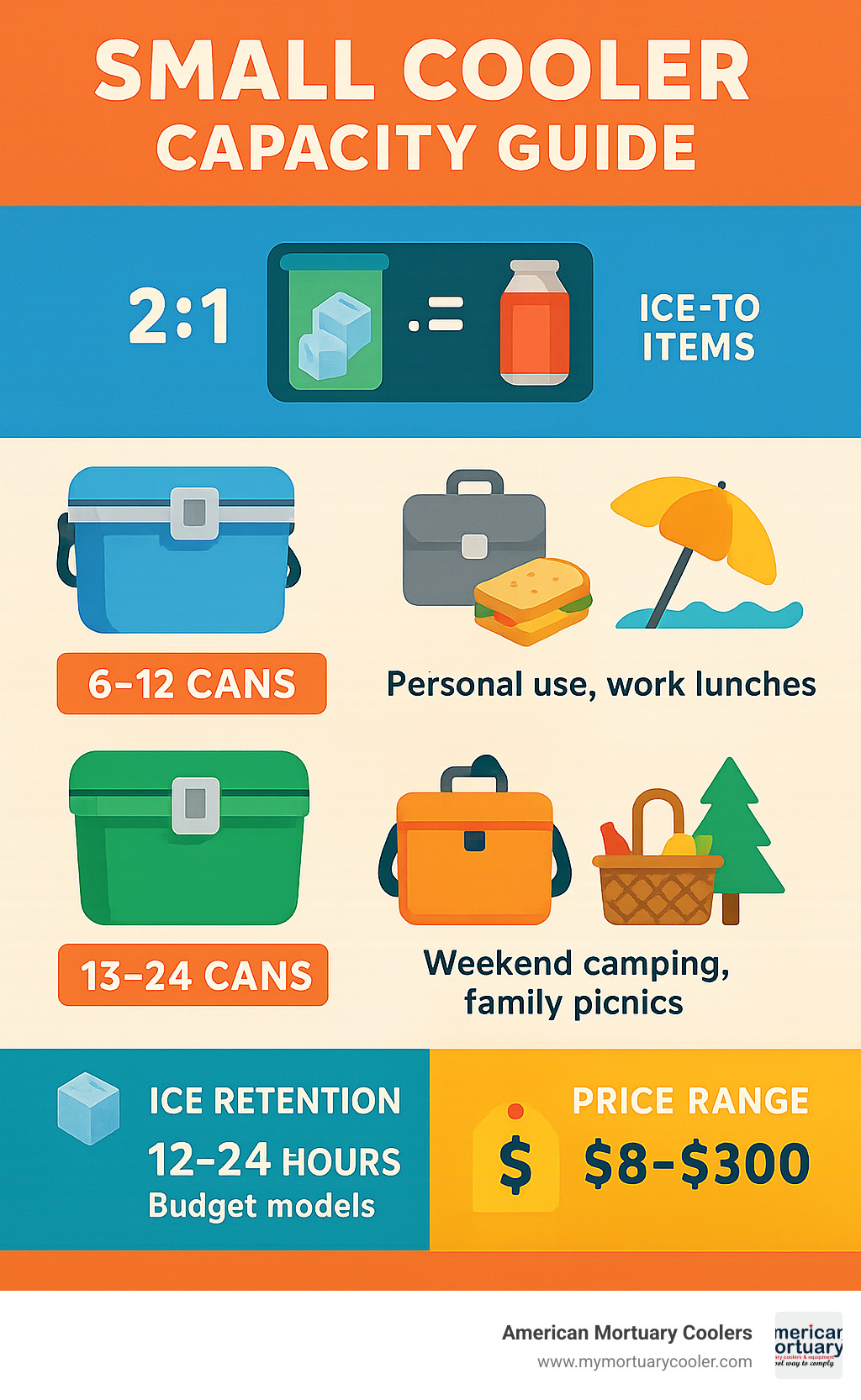
What Is a Small Cooler and When Do You Need One?
Think of a small cooler as your personal refrigerator that goes anywhere you do. These portable insulated containers have come a long way from the basic ice boxes our grandparents used. Today's models pack serious cooling power into compact, lightweight designs that won't slow you down.
Small coolers are sized in two main ways. Can-count sizing tells you exactly what it sounds like - how many standard 12-ounce cans fit inside. You'll see 6-can, 12-can, 18-can, 24-can, and 30-can models. Quart sizing ranges from about 6 quarts up to 35 quarts for what we still call "small" coolers.
Most people find their sweet spot between 12-24 can capacity (roughly 15-25 quarts). This size handles day trips perfectly without turning into a workout every time you pick it up.
You've got two main power options to choose from. Traditional ice-based coolers use good old-fashioned ice or ice packs - they're reliable and work anywhere. Thermoelectric coolers are basically mini-fridges that plug into your car's 12V outlet or wall power.
Typical Uses for a Small Cooler
Work lunches are probably the most common use. Construction workers, office employees, and outdoor workers all rely on small coolers to keep food safe and drinks cold.
Hiking snacks stay fresh and safe in lightweight soft-sided models that won't weigh you down on the trail. Fishing bait needs to stay cool and fresh, making a small cooler essential gear for any serious angler.
Tailgating at sporting events becomes so much more enjoyable when you have cold drinks and fresh food without lugging around a massive cooler. Travel cosmetics and medications that need refrigeration stay at optimal temperatures in hotel rooms or during long trips.
How Long Can a Small Cooler Keep Things Cold?
The secret sauce is closed-cell foam insulation - tiny air pockets that act like thousands of little barriers against heat. Better coolers use thicker foam and more advanced construction techniques.
Budget models ($8-$30) will give you 12-24 hours of ice retention in moderate temperatures. Mid-range models ($30-$100) bump you up to 24-36 hours of ice retention with thicker insulation and better construction. Premium models ($100-$300) deliver 36-48+ hours of ice retention using advanced materials.
The 24-48 hour benchmarks are tested under controlled conditions, but real-world performance depends on several factors. Ambient temperature above 80°F dramatically reduces performance. Pre-chilling your empty cooler before loading extends ice life significantly. The 2:1 ice rule still applies - plan for ice to take up about half your cooler's space for maximum performance.
Main Types of Small Coolers
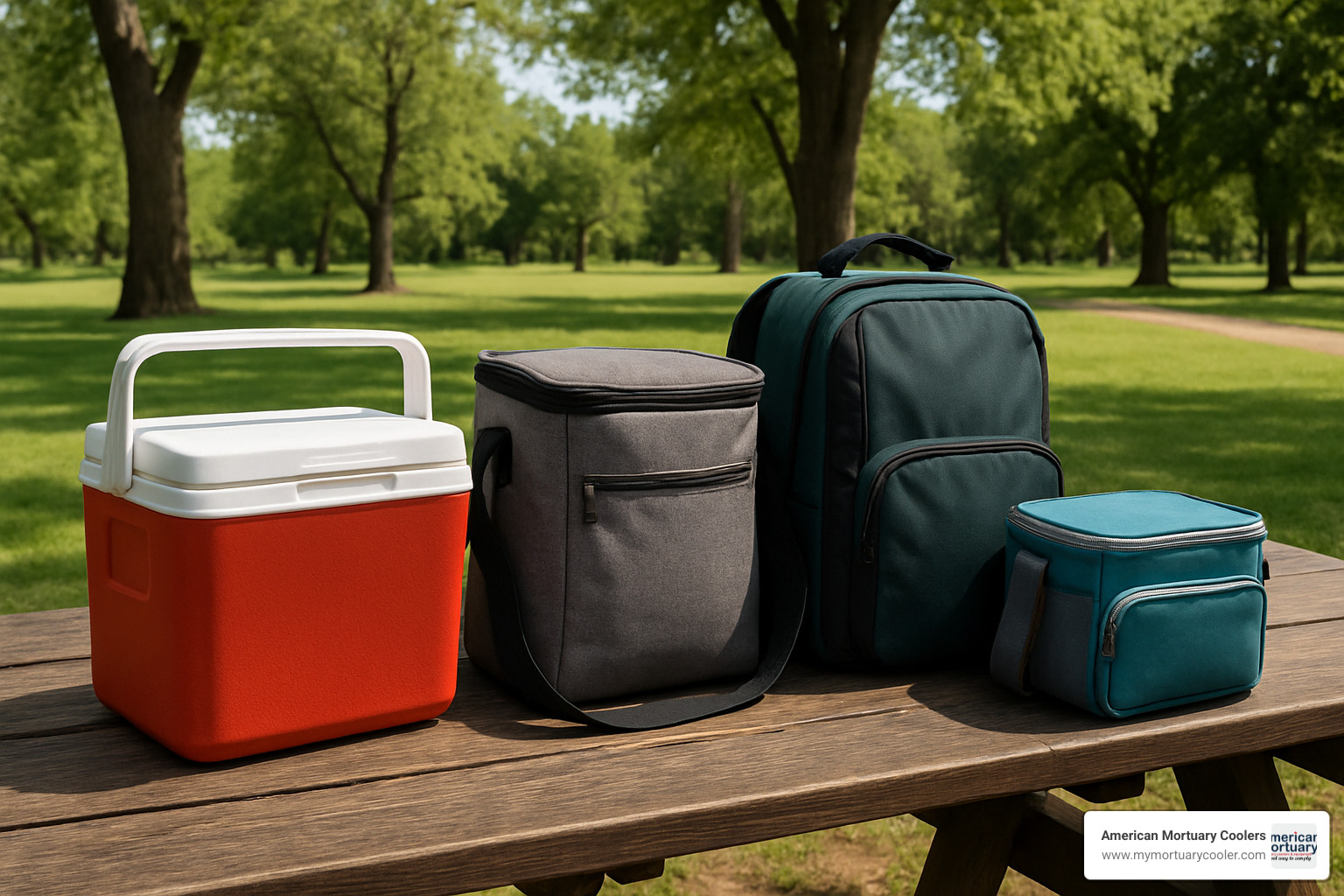
Walk into any outdoor gear store, and you'll quickly find that small cooler options can be overwhelming. The good news? Each type is designed with specific situations in mind, making your choice easier once you know what you need.
Hard-sided coolers are the workhorses of the bunch. Built with rotomolded plastic construction, they're designed to take a beating while keeping your drinks ice-cold for days. They're heavier and bulkier, but they get the job done reliably.
Soft-sided coolers prioritize comfort and convenience. Made with flexible fabric and insulated walls, they're much lighter and easier to carry. They're more comfortable for daily use, even if they don't haul quite as much.
Backpack coolers solve a specific problem: what happens when you need cold drinks but also need your hands free? Whether you're hiking a trail, navigating a crowded beach, or biking to a picnic spot, these coolers let you carry refreshments without compromising your mobility.
Tote coolers bring style to the party. These look more like fashionable bags than utilitarian coolers, making them perfect for upscale beach clubs or office potlucks where appearance matters.
Hard-Sided vs. Soft-Sided Small Coolers
This decision often comes down to how you plan to use your small cooler. Hard-sided models excel at pure performance - they keep things colder for longer and can handle serious abuse.
Hard-sided coolers use thick walls and tight seals to create superior insulation. Their rotomolded construction resists impacts that would puncture soft-sided models. They're also completely leak-proof, making them ideal for transporting liquids or messy items.
The trade-off? Weight and bulk. Even empty, a hard-sided cooler feels substantial.
Soft-sided coolers shine in different situations. They're significantly lighter, making them comfortable to carry even when fully loaded. Many compress when empty, and their flexible construction means they fit into tight spaces.
| Feature | Hard-Sided | Soft-Sided |
|---|---|---|
| Ice Retention | 48+ hours | 24-48 hours |
| Weight (empty) | 5-8 lbs | 2-4 lbs |
| Durability | Excellent | Good |
| Portability | Fair | Excellent |
| Price Range | $50-$300 | $20-$250 |
| Best For | Camping, fishing | Day trips, hiking |
Choosing the Right Small Cooler: Key Features That Matter
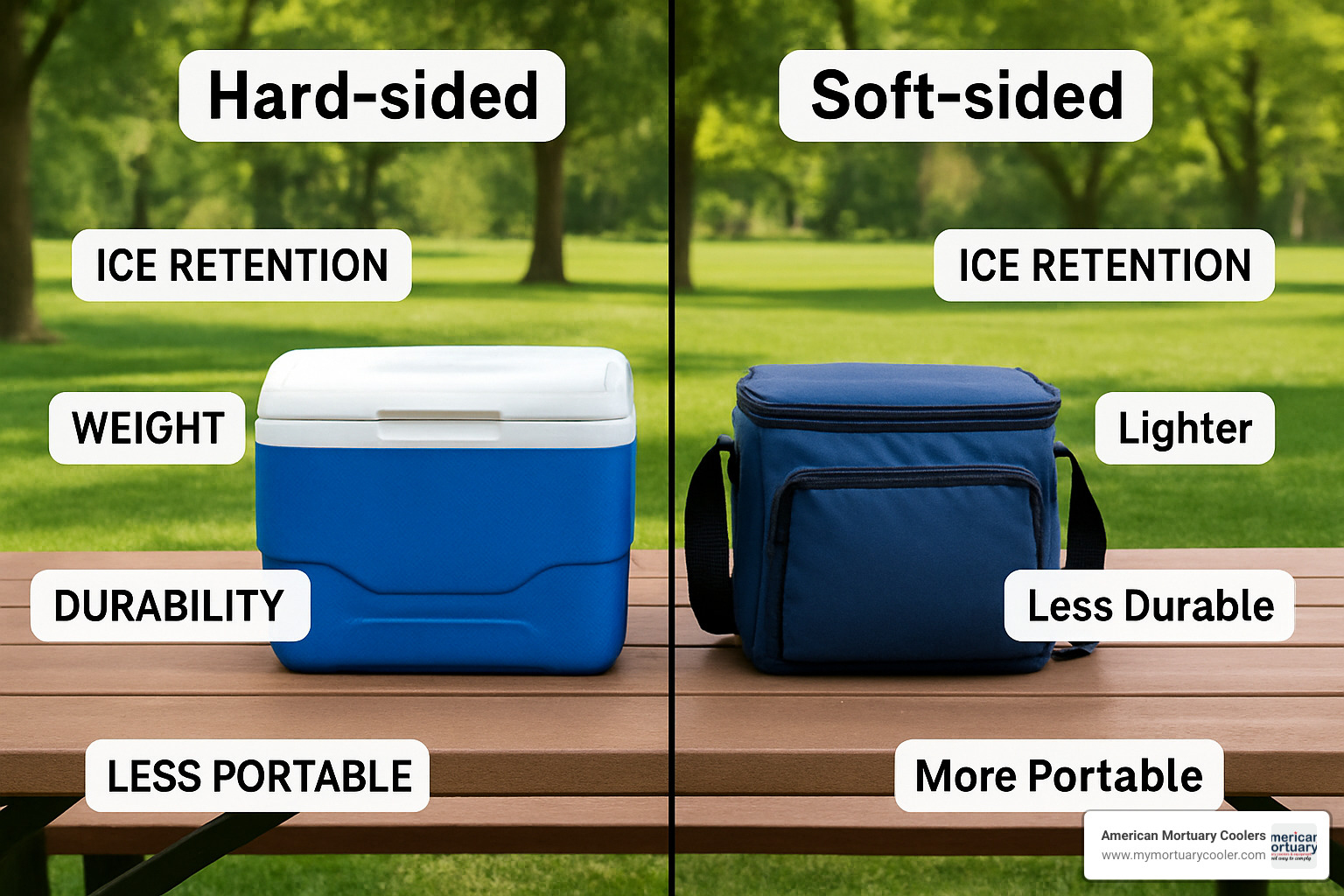
Finding the perfect small cooler feels overwhelming with so many options available. After years of working with cooling technology at American Mortuary Coolers, we've learned which features actually matter versus what's just marketing hype.
The most important consideration is capacity matching. 2:1 ice ratio we mentioned? A 24-can cooler realistically holds 12 cans plus ice. Think about your typical trips - are you packing lunch for one person or snacks for a family beach day? Do you have opportunities to restock ice, or do you need maximum retention for a multi-day camping trip?
Insulation quality separates the coolers that keep ice for 8 hours from those that maintain cold for 48+ hours. Thicker walls generally mean better performance, but the insulation type matters more. Closed-cell foam creates thousands of tiny air pockets that block heat transfer - it's the same principle we use in our commercial refrigeration systems.
The construction materials tell you everything about durability. For soft-sided coolers, look for at least 600D polyester fabric - anything thinner won't survive regular outdoor use. The interior liner should be food-grade rated for safety and easy cleaning. Quality hardware like YKK zippers might seem like a small detail, but a failed zipper ruins your entire trip.
Waterproof ratings matter more than most people realize. There's a huge difference between water-resistant (handles splashes) and truly waterproof (survives river trips). If you're planning water activities or live in a rainy climate, invest in genuine waterproof construction with sealed seams.
Carry options become crucial when you're hiking half a mile to your fishing spot or navigating crowded tailgating lots. Padded handles, adjustable straps, and multiple carrying positions transform a cooler from a burden into a convenience.
Price ranges vary dramatically - from $8 budget models to $300 premium brands. The sweet spot for most users falls between $30-$100, where you get solid performance without paying for extreme features you may not need.
For deeper insights into energy-efficient cooling solutions, check out our comprehensive guide at The Ultimate Guide to Energy-Efficient Coolers.
Determining the Perfect Size & Capacity
Getting the size right prevents the frustration of running out of space or lugging around more cooler than you need. Here's how different capacities work in real life:
6-can coolers (6-8 quarts) work perfectly for personal use. You'll fit about 3 cans plus ice, or 4-5 items without ice. These excel for work lunches, medication transport, or solo day trips. The Ozark Trail 6-Can at $7.94 proves you don't need to spend much for basic performance.
12-can coolers (12-15 quarts) hit the sweet spot for couples and small groups. With 6 cans plus ice, they're ideal for day hikes, picnic dates, or office lunches. The Yeti Hopper Flip 8 actually holds 11 cans and showcases how premium construction maximizes space efficiency.
18-can coolers (18-22 quarts) handle family beach days and weekend camping. You'll get 9 cans plus ice, or 12-15 items without ice. This size works well when you need variety - drinks, snacks, and maybe some sandwich ingredients.
24-can coolers (24-28 quarts) serve families and friend groups perfectly. With 12 cans plus ice, they're great for tailgating, family camping, or day-long events. The Yeti Hopper Flip 12 holds 24 cans and demonstrates how smart design maximizes capacity.
30+ can coolers (30-35 quarts) work for large groups and extended trips. The RTIC Soft Pack 30 and Hydro Flask Day Escape (which holds 42 cans!) fall into this category. They're perfect for party hosting or multi-day camping where resupply isn't possible.
Activity matching matters more than raw capacity. A solo angler needs reliable ice retention for bait more than massive capacity. A family beach trip prioritizes easy access and comfortable carrying over extreme performance.
Materials & Construction for Maximum Ice Retention
The difference between a cooler that keeps ice for 8 hours versus 48 hours comes down to materials and construction quality. We've seen this principle in our commercial cooling systems - the details matter enormously.
Insulation technology forms the heart of any small cooler. Closed-cell foam creates thousands of tiny air pockets that resist heat transfer. It's like having millions of tiny thermoses working together. Vacuum insulation, used in premium models, takes this concept further by removing air entirely from the insulation space.
Exterior shell materials determine durability and performance. Rotomolded polyethylene, used in high-end hard-sided coolers, creates seamless construction without weak points. For soft-sided models, 600D polyester represents the minimum standard for regular outdoor use. TPU laminate coatings provide waterproof protection while maintaining flexibility.
Interior liner specifications affect both performance and hygiene. Food-grade materials ensure safety and resist staining. Antimicrobial treatments prevent odor buildup and bacterial growth - crucial for coolers that see regular use. Smooth interior surfaces clean easily and don't harbor bacteria in textured areas.
Seam construction often determines whether a cooler truly performs as advertised. RF-welded seams use radio frequency energy to literally melt materials together, creating waterproof joints stronger than the original fabric. Heat-sealed seams offer similar benefits at lower cost. Basic sewn and sealed construction works for light use but may fail under stress.
Hardware quality separates coolers that last years from those that fail after a season. YKK zippers have earned their reputation through decades of reliable performance. Waterproof zippers cost more but enable true submersion capability. Reinforced stress points at handles and corners prevent the most common failure modes.
Waterproof vs. Water-Resistant—Why It Matters for a Small Cooler
This distinction confuses many buyers, but understanding it helps you choose the right small cooler for your activities. The difference isn't just technical - it affects where and how you can use your cooler.
Waterproof coolers prevent any water penetration in either direction. They feature welded seams, waterproof zippers, and sealed joints throughout. You can literally submerge them without water entering or ice water escaping. The Yeti Hopper series with HydroLok zippers exemplifies this construction.
Water-resistant coolers repel water but aren't completely sealed. They handle splashes, light rain, and typical outdoor conditions well. Most budget and mid-range soft-sided coolers fall into this category. They use water-repellent coatings and basic seam sealing.
The practical difference becomes obvious during use. River floating demands waterproof construction - if your cooler tips over, water won't flood in and ruin everything. Beach use benefits from waterproof design because sand and saltwater won't penetrate the cooler. Rain protection means your food stays dry even in unexpected downpours.
Leak prevention works both ways. Waterproof coolers won't leak melted ice water into your car or tent. This matters more than you might think - we've all experienced the frustration of finding a puddle where our cooler was sitting.
Marine environments, river trips, and extended camping justify the investment in waterproof construction. For basic picnics and day trips, water-resistant models often suffice and cost significantly less. Consider your most demanding use case when making this decision.
Best Small Coolers of 2024—Top Picks Compared
For a quick primer on how modern portable coolers evolved, see this overview. After combing through lab data, field tests, and thousands of user reviews, these five models rose to the top. We focused on real-world ice life, build quality, and value—not hype.
Best Overall
RTIC Soft Pack 30
30-can capacity, up to 48-hour ice retention, welded seams, under 5 lb empty. At roughly $140 it delivers premium performance for a mid-range price.
Most Durable
Yeti Hopper Flip 12
DryHide™ shell and HydroLok™ zipper make this 24-can (realistically ~13 with ice) soft cooler nearly indestructible. Holds ice for two full days; backed by a 3-year warranty. Expect to pay about $250.
Budget Pick
Ozark Trail 6-Can
Under $10, weighs less than 1 lb, and keeps lunch cold for 12-18 hours. Perfect when you need something simple and disposable-priced.
Best Backpack
Arctic Zone Titan Deep Freeze
Hands-free comfort, two insulated compartments, and 24-can total capacity. Lab tests confirmed 36-48 hour ice life when packed 2:1 with ice.
Best Electric
Koolatron 18-Quart Thermoelectric
Plugs into any 12 V outlet, cools to 40 °F below ambient (or heats to 130 °F). No ice, no mess—ideal for road trips.
Using, Cleaning & Maintaining Your Small Cooler
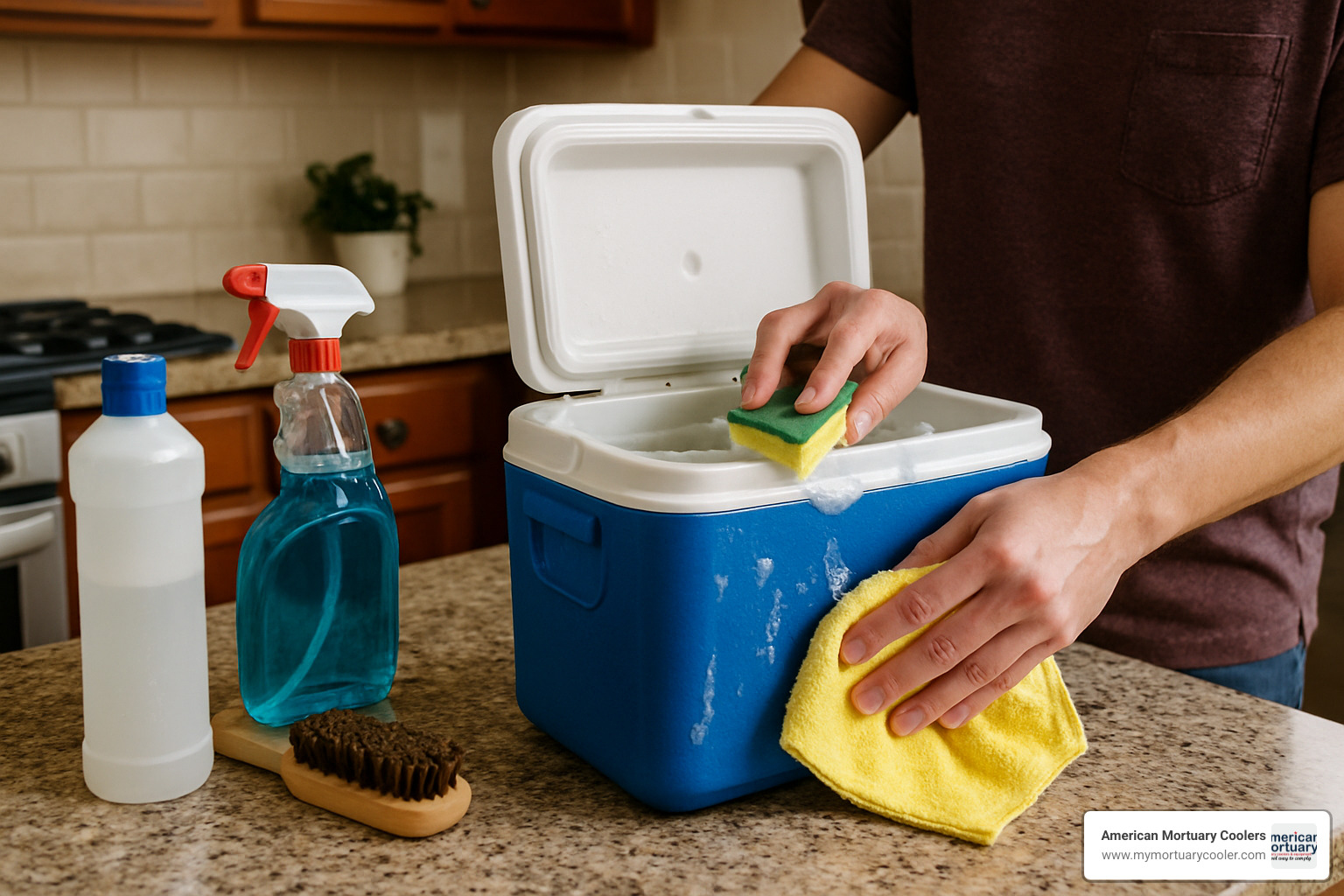
A few habits will stretch ice life and your cooler’s lifespan.
- Pre-chill everything – stash the empty cooler (and its contents) in the fridge or add sacrificial ice for 30 minutes.
- Use more block ice – blocks melt 2-3× slower than cubes; frozen water bottles double as drinking water later.
- Pack tight & layer – block ice on the bottom, food/drinks in the middle, loose ice on top. Less empty air means longer chill time.
- Keep it closed & shaded – every lid lift dumps cold air; a reflective blanket or a tree’s shade can add several hours of ice life.
Quick Cleaning Routine
- Rinse with warm soapy water after each trip.
- Tackle odors with a baking-soda rinse (2 Tbsp per quart of water).
- Air-dry completely with the lid or zipper open.
- Lubricate zippers/gaskets occasionally with food-grade silicone or plain bar soap.
Follow these steps and even a budget cooler should perform well for years.
Frequently Asked Questions About Small Coolers
Hard-Sided vs. Soft-Sided—Which Should I Buy?
Hard-sided models win on raw ice retention and impact resistance, making them ideal for multi-day camping or boating. Soft-sided versions are lighter, compressible, and far easier to carry through crowds or on hikes. If you’ll move the cooler often, go soft; if it mostly stays parked, go hard.
Are All Small Coolers Waterproof?
No. Premium soft coolers with welded seams and waterproof zippers (Yeti, RTIC, Hydro Flask) can survive a dunking. Budget models are usually only water-resistant—fine for rain, not submersion. Match the rating to your worst-case scenario.
What’s the Right Ice-to-Item Ratio?
Aim for a 2:1 volume ratio of ice to contents for trips longer than four hours. Short outings or cool weather can drop to 1:1, but anything less will noticeably cut ice life. Pack block ice on the bottom, items in the middle, and cubes or crushed ice on top.
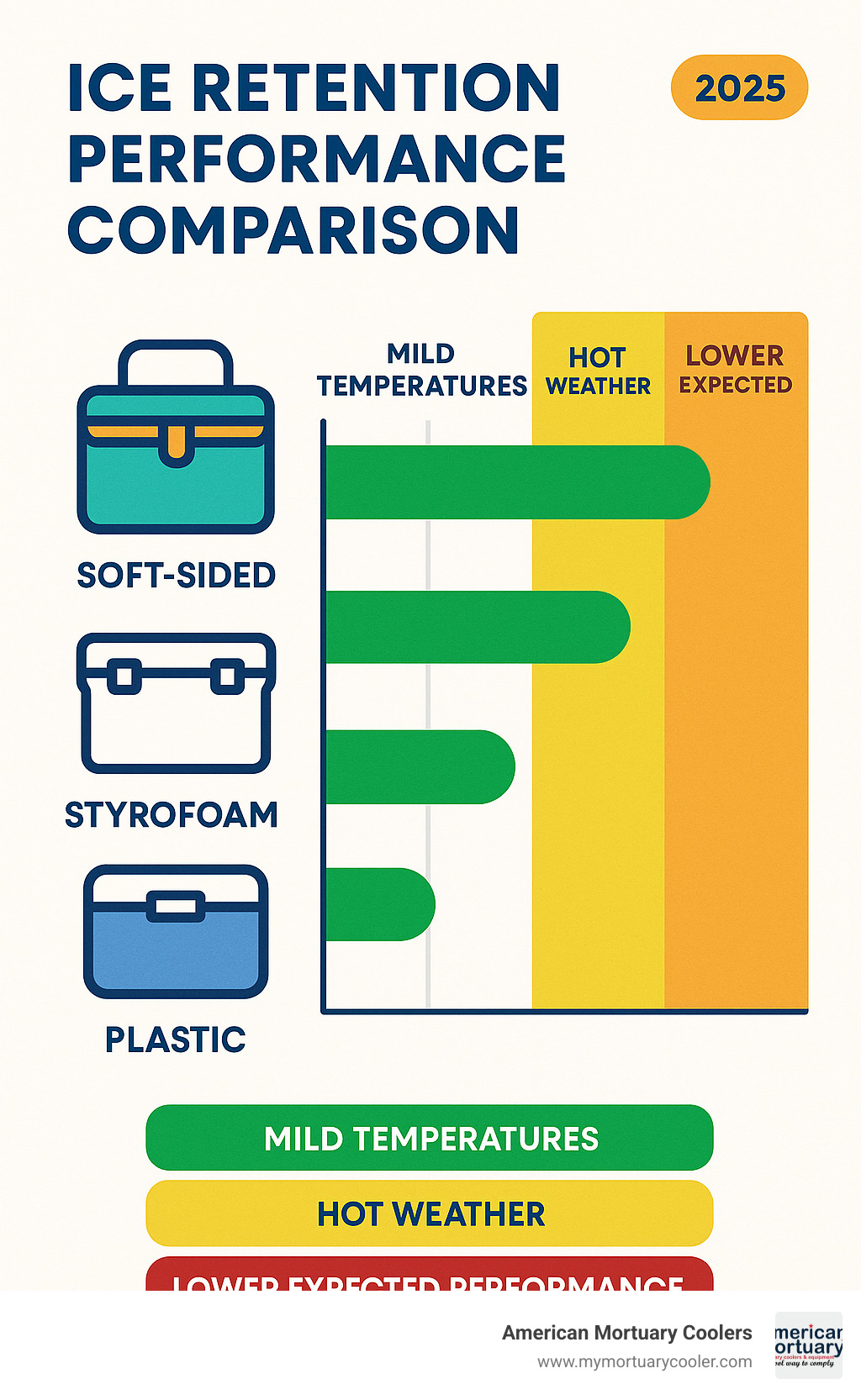
Conclusion
Choosing the perfect small cooler is like finding the right tool for any job - it all comes down to understanding what you really need and how much you're willing to invest in quality.
After diving deep into sizes, materials, and real-world performance, the truth is refreshingly simple: there's genuinely a small cooler out there for every lifestyle and budget. The construction worker who needs lunch kept cold on a hot jobsite has different needs than the weekend warrior heading out for a two-day camping trip.
The fundamentals haven't changed - that crucial 2:1 ice ratio still determines whether you'll have cold drinks at the end of your trip. Premium materials and waterproof construction do justify higher prices, but only if you'll actually use those features. There's no shame in choosing a basic $8 Ozark Trail cooler if it meets your needs perfectly.
What has changed is the incredible variety available today. Backpack styles free your hands for hiking trips, while neat totes blend seamlessly into social gatherings. Hard-sided models offer maximum protection for serious outdoor use, and electric options eliminate the ice guessing game entirely.
Our testing and analysis consistently point to these standouts: The RTIC Soft Pack Cooler delivers premium performance at a reasonable price point. The Yeti Hopper Flip 12 represents the gold standard for durability and construction quality. For basic needs, the Ozark Trail 6-Can proves you don't need to spend big for reliable cooling. The Arctic Zone Titan solves the portability puzzle with comfortable backpack design. And the Koolatron 18-qt offers ice-free convenience for road trip enthusiasts.
Here at American Mortuary Coolers, our daily work with commercial refrigeration and temperature control gives us a unique perspective on cooling equipment. While we specialize in custom mortuary coolers for funeral homes across Tennessee and the contiguous 48 states, the same engineering principles apply whether you're preserving dignity in our industry or keeping your weekend beverages perfectly chilled.
Proper maintenance truly makes the difference between a cooler that lasts one season and one that serves you faithfully for years. A simple cleaning routine and smart packing strategies can double your ice retention time and prevent those unpleasant surprises when you open the lid.
The right small cooler becomes an invisible part of your trips - you stop thinking about whether your drinks will be cold and start focusing on making memories. Whether you're packing a simple work lunch or gearing up for an epic weekend getaway, that peace of mind is worth the investment.
Stay cool out there, and remember that the best cooler is the one that actually gets used. Choose based on your real needs, not the most impressive specifications, and you'll find yourself reaching for it again and again.
For more information about portable cooling solutions and our expertise in temperature control, visit our comprehensive guide at More info about portable cooling solutions.



